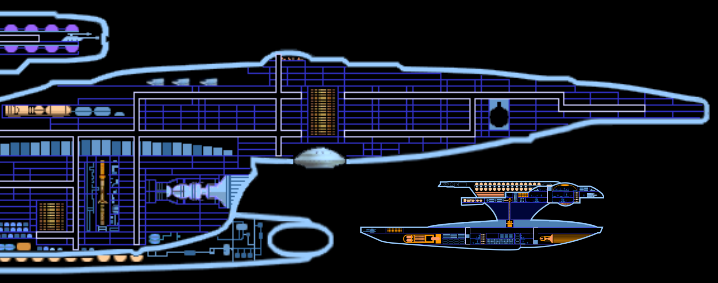I've seen this Oberth/tug concept before and it just doesn't make any sense to me and to be honest, rather smacks of kit bashing.
I've roughed out the general layout of the primary hull decks and there's plenty of room to cram in 80 people. If you need a larger crew than that, or greater cargo capacity, then the Oberth is simply the wrong ship for the task; send a Miranda or Antares-Class Surveyor instead!
A starship is a piece of equipment and like anything we have to day it has a certain limitations to it's functionality. It dose what it does and maybe a little more when push comes to shove but NOTHING is designed to do EVERYTHING (except perhaps TMA-1 .)
.)
Sure, it's modular, but only to a point. I thought keeping the modules internal makes more sense than slapping on all kinds of pods, antennae and whatnot and it also keeps the design in line with what we've seen onscreen. Hell, even the Pegasus; an advanced prototype was externally indistinguishable from any other Oberth-Class vessel. So I think internalised modularity is the best way to go. No need to invent functions that need not apply. I'm sure starfleet has plenty of other tugs, larger surveyors, scouts and science vessels to suit the various roles of a Federation Starship.
I've roughed out the general layout of the primary hull decks and there's plenty of room to cram in 80 people. If you need a larger crew than that, or greater cargo capacity, then the Oberth is simply the wrong ship for the task; send a Miranda or Antares-Class Surveyor instead!
A starship is a piece of equipment and like anything we have to day it has a certain limitations to it's functionality. It dose what it does and maybe a little more when push comes to shove but NOTHING is designed to do EVERYTHING (except perhaps TMA-1
 .)
.) Sure, it's modular, but only to a point. I thought keeping the modules internal makes more sense than slapping on all kinds of pods, antennae and whatnot and it also keeps the design in line with what we've seen onscreen. Hell, even the Pegasus; an advanced prototype was externally indistinguishable from any other Oberth-Class vessel. So I think internalised modularity is the best way to go. No need to invent functions that need not apply. I'm sure starfleet has plenty of other tugs, larger surveyors, scouts and science vessels to suit the various roles of a Federation Starship.


 Having more space for a turbolift car to move through and probably some plasma conduits for power if nothing else would definitely be more rational.
Having more space for a turbolift car to move through and probably some plasma conduits for power if nothing else would definitely be more rational.